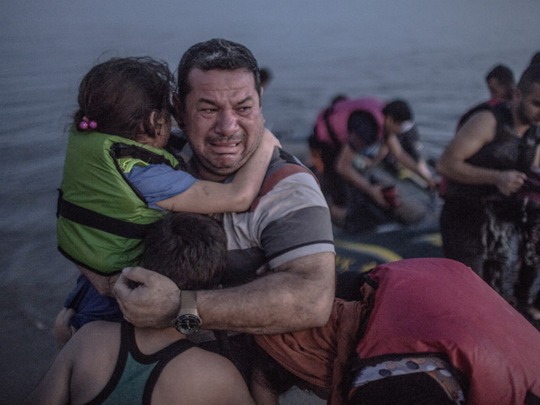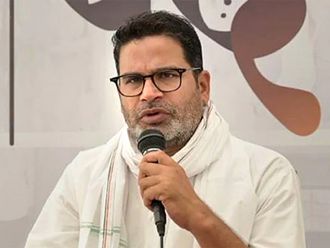
He is a dad. He is carrying his children to safety. And he is crying. It is not hard to work out why Laith Majid, the Syrian who was photographed by Daniel Etter as he arrived by boat to Greece this week, has struck a chord with so many people.
In the media debate on the biggest wave of mass-migration since the Second World War, most of the protagonists have been dehumanised.
At best they are merely numbers. At worst we call them marauders, swarms and cockroaches. But Majid is a rare counterpoint. He is someone whose humanity at last forces one to briefly admit that many of these migrants are people not so different from “us”. And that is partly what makes his picture so heartbreaking.
As the Guardian’s migration correspondent, it has been my job to report on this crisis in most of its forms — on the shores of Libya, Egypt, Greece and Italy; in the plains of Serbia, Hungary and Macedonia; and now in the sands of the Sahara, where I write. One of the saddest things about this image of Majid is that it is not in any way unique, even though it is being treated as such. You can find similar devotion among thousands of men and women trying to reach Europe.
The 36-year-old Syrian interior designer I walked with over the Macedonian border was not travelling alone. In his arms, he carried little Hammouda, a one-year-old boy who has only ever known war or the desperation of fleeing it. This man and most other refugees are not photographed crying as they reach Europe — but many of them are parents going through the same trauma as Majid. And they are largely being ignored.
Perhaps the most depressing aspect to this image is that it will not change anything. The second thing that struck me while looking at Majid’s picture was how unremarkable this moment will be in the context of his journey as a whole. Captured in a photograph, this scene may seem the climax of an odyssey. But really, it is just the latest of so many hardships that will continue until Majid gains asylum in northern Europe — assuming he ever gets there.
First, he would have had to escape the clutches of Daesh (the self-proclaimed Islamic State of Iraq and the Levant) in Deir Ezzor. Then there is the trek through the badlands of northern Syria and the death-trap just before the Turkish border. This trip across the Aegean Sea will be followed by limbo on the Greek islands, while he waits for permission to reach the Greek mainland. Then there is the march through the Balkans, the likelihood of being stopped on the now-closed Macedonian border, or being mugged by bandits in Serbia, or arrested at Hungary’s new border fence. So many things could still go wrong.
Earlier this summer, I watched dozens of Afghans and Syrians land on the shores of Lesbos, another Greek island. I had expected it to feel like a watershed for these travellers, the moment they reached the safety of the European Union. Instead, most of them did not even stop, aside from one or two who took selfies. But the majority simply threw away their lifejackets, scrambled up some scree — and then started walking the 40 miles (64km) to the island’s capital. Reaching Greece is not quite a footnote in their quest.
But it is not the panacea Majid’s photograph may suggest. Perhaps the most depressing aspect to this image is that it will not change anything. Some see the picture as a game changer: Something that can help alter the toxic debate about migration. But I am not so sure. It has obviously affected a lot of people who perhaps did not expect to be so moved. But for every one of them, there are still many others who do not care.
Earlier this summer, we covered the story of Hashem Alsouki, who risked death in the Mediterranean to try to build a future for his children. Many readers were moved by his plight. But others described him as a criminal.
Tugging on heart-strings only gets you so far. At a certain point, perhaps, one simply has to talk in more practical terms. You may not be moved. You may not want migrants in your country. You may think the problem will disappear if a few fences are erected here and there. But the hard reality is that it will not. People like Majid will still come in their thousands. Their passage cannot be avoided; it can only be better managed. And the logic of this argument stands, with or without a photograph.
— Guardian News & Media Ltd










